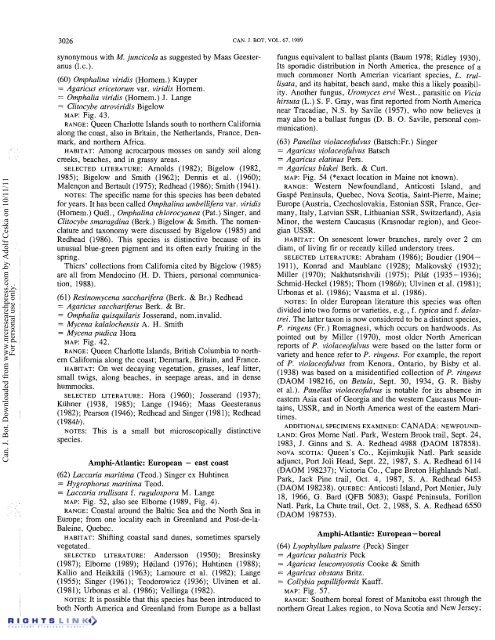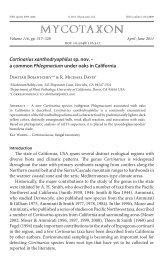Redhead Fungal Biogeography.pdf - Mushroom Hobby
Redhead Fungal Biogeography.pdf - Mushroom Hobby
Redhead Fungal Biogeography.pdf - Mushroom Hobby
Create successful ePaper yourself
Turn your PDF publications into a flip-book with our unique Google optimized e-Paper software.
Can. J. Bot. Downloaded from www.nrcresearchpress.com by Adolf Ceska on 10/11/11<br />
For personal use only.<br />
3026<br />
CAN. J. BOT.<br />
synonymous with M. juncicola as suggested by Maas Geester-<br />
anus (1.c.).<br />
(60) Omphalina viridis (Hornem.) Kuyper<br />
= Agaricus ericetorum var. viridis Hornem.<br />
= Omphalia viridis (Hornem.) J. Lange<br />
= Clitocybe atroviridis Bigelow<br />
MAP: Fig. 43.<br />
RANGE: Queen Charlotte Islands south to northern California<br />
along the coast, also in Britain, the Netherlands, France, Denmark,<br />
and northern Africa.<br />
HABITAT: Among acrocarpous mosses on sandy soil along<br />
creeks, beaches, and in grassy areas.<br />
SELECTED LITERATURE: Arnolds (1982); Bigelow (1982,<br />
1985); Bigelow and Smith (1962); Dennis et al. (1960);<br />
Malen~on and Bertault (1975); <strong>Redhead</strong> (1986); Smith (1941).<br />
NOTES: The specific name for this species has been debated<br />
for years. It has been called Omphalina urnbellifera var. viridis<br />
(Hornem.) QuCl., Omphalina chlorocyanea (Pat.) Singer, and<br />
Clitocybe smaragdina (Berk.) Bigelow & Smith. The nomenclature<br />
and taxonomy were discussed by Bigelow (1985) and<br />
<strong>Redhead</strong> (1986). This species is distinctive because of its<br />
unusual blue-green pigment and its often early fruiting in the<br />
spring.<br />
Thiers' collections from California cited by Bigelow (1985)<br />
are all from Mendocino (H. D. Thiers, personal communication,<br />
1988).<br />
(61) Resinomycena saccharifera (Berk. & Br.) <strong>Redhead</strong><br />
= Agaricus sacchariferus Berk. & Br.<br />
= Omphalia quisquilaris Josserand, nom. invalid.<br />
= Mycena kalalochensis A. H. Smith<br />
= Mycena pudica Hora<br />
MAP: Fig. 42.<br />
RANGE: Queen Charlotte Islands, British Columbia to northern<br />
California along the coast; Denmark, Britain, and France.<br />
HABITAT: On wet decaying vegetation, grasses, leaf litter,<br />
small twigs, along beaches, in seepage areas, and in dense<br />
hummocks.<br />
SELECTED LITERATURE: Hora (1960); Josserand (1937);<br />
Kiihner (1938, 1985); Lange (1946); Maas Geesteranus<br />
(1982); Pearson (1946); <strong>Redhead</strong> and Singer (1981); <strong>Redhead</strong><br />
(1984b).<br />
NOTES: This is a small but microscopically distinctive<br />
species.<br />
Amphi-Atlantic: European - east coast<br />
(62) Luccaria maritima (Teod.) Singer ex Huhtinen<br />
= Hygrophorus maritima Teod.<br />
= Luccaria trullisata f. rugulospora M. Lange<br />
MAP: Fig. 52, also see Elborne (1989, Fig. 4).<br />
RANGE: Coastal around the Baltic Sea and the North Sea in<br />
Europe; from one locality each in Greenland and Post-de-la-<br />
Baleine, Quebec.<br />
HABITAT: Shifting coastal sand dunes, sometimes sparsely<br />
vegetated.<br />
SELECTED LITERATURE: Andersson (1950); Bresinsky<br />
(1987); Elborne (1989); Hpliland (1976); Huhtinen (1988);<br />
Kallio and Heikkila (1963); Lamoure et al. (1982); Lange<br />
(1955); Singer (1961); Teodorowicz (1936); Ulvinen et al.<br />
(1981); Urbonas et al. (1986); Vellinga (1982).<br />
NOTES: It is possible that this species has been introduced to<br />
both North America and Greenland from Europe as a ballast<br />
fungus equivalent to ballast plants (Baum 1978; Ridley 1930).<br />
Its sporadic distribution in North America, the presence of a<br />
much commoner North Amerian vicariant species, L. trullisata,<br />
and its habitat, beach sand, make this a likely possibility.<br />
Another fungus, Uromyces ervi West., parasitic on Vicia<br />
hirsuta (L.) S. F. Gray, was first reported from North America<br />
near Tracadiae, N.S. by Savile (1957), who now believes it<br />
may also be a ballast fungus (D. B. 0. Savile, personal communication).<br />
(63) Panellus violaceofulvus (Batsch:Fr.) Singer<br />
= Agaricus violaceofulvus Batsch<br />
= Agaricus elatinus Pers.<br />
= Agaricus blakei Berk. & Curt.<br />
MAP: Fig. 54 (*exact location in Maine not known).<br />
RANGE: Western Newfoundland, Anticosti Island, and<br />
Gasp6 Peninsula, Quebec, Nova Scotia, Saint-Pierre, Maine;<br />
Europe (Austria, Czechoslovakia, Estonian SSR, France, Germany,<br />
Italy, Latvian SSR, Lithuanian SSR, Switzerland), Asia<br />
Minor, the western Caucasus (Krasnodar region), and Georgian<br />
USSR.<br />
HABITAT: On senescent lower branches, rarely over 2 cm<br />
diam, of living fir or recently killed understory trees.<br />
SELECTED LITERATURE: Abraham (1986); Boudier (1904-<br />
191 I), Konrad and Maublanc (1928); Malkovskjl (1932);<br />
Miller (1970); Nakhutsrishvili (1975); Pilit (1935 - 1936);<br />
Schmid-Heckel (1985); Thorn (1986b); Ulvinen et al. (1981);<br />
Urbonas et al. (1986); Vaasma et al. (1986).<br />
NOTES: In older European literature this species was often<br />
divided into two forms or varieties, e.g., f. typica and f. delastrei.<br />
The latter taxon is now considered to be a distinct species,<br />
P. ringens (Fr.) Romagnesi, which occurs on hardwoods. As<br />
pointed out by Miller (1970), most older North American<br />
reports of P. violaceofulvus were based on the latter form or<br />
variety and hence refer to P. ringens. For example, the report<br />
of P. violaceofulvus from Kenora, Ontario, by Bisby et al.<br />
(1938) was based on a misidentified collection of P. ringens<br />
(DAOM 198216, on Betula, Sept. 30, 1934, G. R. Bisby<br />
et al.). Panellus violaceofulvus is notable for its absence in<br />
eastern Asia east of Georgia and the western Caucasus Mountains,<br />
USSR, and in North America west of the eastern Maritimes.<br />
ADDITlONAL SPECIMENS EXAMINED: CANADA: NEWFOUND-<br />
LAND: Gros Morne Natl. Park, Western Brook trail, Sept. 24,<br />
1983, J. Ginns and S. A. <strong>Redhead</strong> 4988 (DAOM 187858).<br />
NOVA SCOTIA: Queen's Co., Kejimkujik Natl. Park seaside<br />
adjunct, Port Joli Head, Sept. 22, 1987, S. A. <strong>Redhead</strong> 61 14<br />
(DAOM 198237); Victoria Co., Cape Breton Highlands Natl.<br />
Park, Jack Pine trail, Oct. 4, 1987, S. A. <strong>Redhead</strong> 6453<br />
(DAOM 198238). QUEBEC: Anticosti Island, Port Menier, July<br />
18, 1966, G. Bard (QFB 5083); Gasp6 Peninsula, Forillon<br />
Natl. Park, La Chute trail, Oct. 2, 1988, S. A. <strong>Redhead</strong> 6550<br />
(DAOM 198753).<br />
Amphi-Atlantic: European- boreal<br />
(64) Lyophyllum palustre (Peck) Singer<br />
= Agaricus palustris Peck<br />
= Agaricus leucomyosotis Cooke & Smith<br />
= Agaricus obstans Britz.<br />
= Collybia papilliformis Kauff.<br />
MAP: Fig. 57.<br />
RANGE: Southern boreal forest of Manitoba east through the<br />
northern Great Lakes region, to Nova Scotia and New Jersey;



